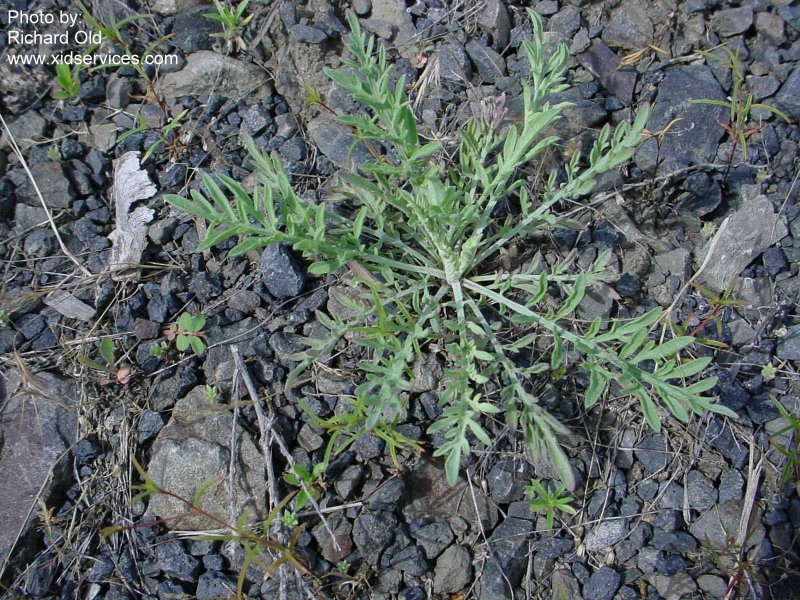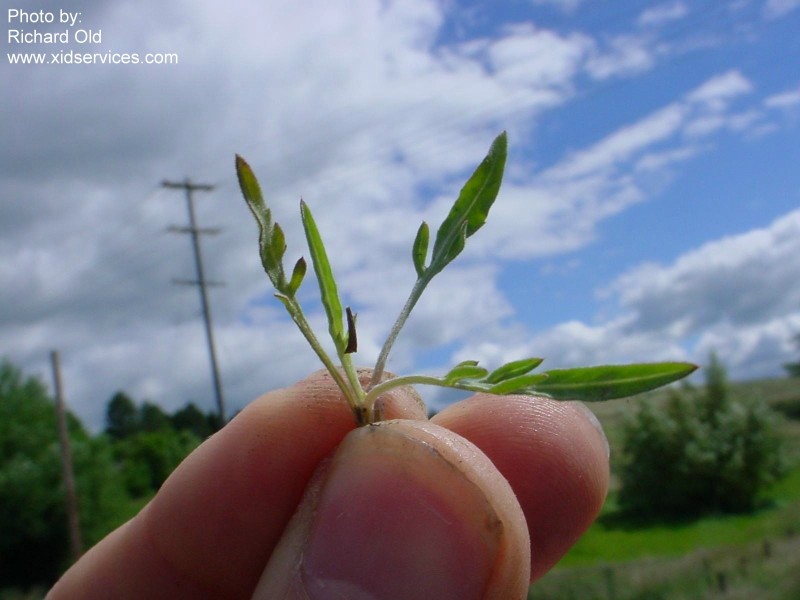Difference between revisions of "Centaurea diffusa"
From RoguesGallery
(New page: Legend for Species Pages <h3> </h3><em> </em> <ul> <li>ANPC Rank – <strong></strong></li> <li>Moss, Flora of Alberta – <strong></strong></li> <li>Global Invasive Specie...) |
|||
| (8 intermediate revisions by the same user not shown) | |||
| Line 1: | Line 1: | ||
[[Legend for Species Pages]] | [[Legend for Species Pages]] | ||
| − | <h3> </h3><em> </em> | + | <h3>Diffuse Knapweed </h3><em>Centaurea diffusa </em> Lam. |
<ul> | <ul> | ||
| − | + | <li>Moss, Flora of Alberta – <strong>Rare</strong></li> | |
| − | <li>Moss, Flora of Alberta – <strong></strong></li> | + | <li>Global Invasive Species Database – <strong>Yes</strong>[http://www.issg.org/database/species/ecology.asp?si=313&fr=1&sts=sss]</li> |
| − | <li>Global Invasive Species Database – <strong></strong></li> | + | <li>NatureServe Rank – <strong>High</strong></li> |
| − | <li>NatureServe Rank – <strong></strong></li> | + | |
| − | <li>Haber, Upland – <strong></strong></li> | + | <li>Haber, Upland – <strong>No</strong></li> |
| − | <li>Haber, Wetland – <strong></strong></li> | + | <li>Haber, Wetland – <strong>No</strong></li> |
| − | <li>CWF, Status & Invasive Range – <strong></strong></li> | + | <li>CWF, Status & Invasive Range – <strong>Potential, BC, SK, AB, MB, ON, QC, NF & Northern NWT, Yukon</strong></li> |
| − | <li>Alberta Revegetation Guidelines – <strong></strong></li> | + | <li>Alberta Revegetation Guidelines – <strong>No</strong></li> |
| − | <li>The Nature Conservancy – <strong></strong></li> | + | <li>The Nature Conservancy – <strong>Yes, w/ ESA</strong></li> |
| − | <li>CBCN – <strong></strong></li> | + | <li>CBCN – <strong>No</strong></li> |
| − | <li>AB Weed – <strong></strong></li> | + | <li>AB Weed – <strong>Prohibited Noxious</strong></li> |
</ul> | </ul> | ||
| + | |||
<h3>Remarks</h3> | <h3>Remarks</h3> | ||
| + | Rare, a pioneer species that can quickly invade disturbed and undisturbed grassland, shrubland, and riparian communities. Once established, it outcompetes and reduces the abundance of desirable native species. It contains the allelopathic chemical cnicin, which can suppress the growth of other species. It is usually described as a biennial, but actually often lives longer---although it does die after flowering and producing seed. | ||
| + | |||
| + | [http://wiki.bugwood.org/Centaurea_diffusa] Link to Bugwood Invasipedia for extensive information on biology, ecology, and management of this species. | ||
| + | |||
| + | [[Image:Centdiff_XID_Centaurea_diffusa1.jpg |frame|none| ]] | ||
| + | [[Image:Centdiff_XID_Centaurea_diffusa2.jpg |frame|none| ]] | ||
| + | [[Image:Centdiff_XID_Centaurea_diffusa8.jpg |frame|none| ]] | ||
| + | [[Image:Centdiff_XID_Centaurea_diffusa11.jpg |frame|none| ]] | ||
| + | |||
| + | <h3>References</h3> | ||
| + | Roché C.T., and B.F. Roché Jr. 2000. Identification of Knapweeds and Starthistles in the Pacific Northwest: PNW432. Pacific Northwest Extension Publication. 22 pp. [http://www.invasiveplants.ab.ca/Downloads/Roche%202000%20identification%20of%20knapweeds.pdf] | ||
Latest revision as of 15:57, 6 October 2010
Diffuse Knapweed
Centaurea diffusa Lam.- Moss, Flora of Alberta – Rare
- Global Invasive Species Database – Yes[1]
- NatureServe Rank – High
- Haber, Upland – No
- Haber, Wetland – No
- CWF, Status & Invasive Range – Potential, BC, SK, AB, MB, ON, QC, NF & Northern NWT, Yukon
- Alberta Revegetation Guidelines – No
- The Nature Conservancy – Yes, w/ ESA
- CBCN – No
- AB Weed – Prohibited Noxious
Remarks
Rare, a pioneer species that can quickly invade disturbed and undisturbed grassland, shrubland, and riparian communities. Once established, it outcompetes and reduces the abundance of desirable native species. It contains the allelopathic chemical cnicin, which can suppress the growth of other species. It is usually described as a biennial, but actually often lives longer---although it does die after flowering and producing seed.
[2] Link to Bugwood Invasipedia for extensive information on biology, ecology, and management of this species.
References
Roché C.T., and B.F. Roché Jr. 2000. Identification of Knapweeds and Starthistles in the Pacific Northwest: PNW432. Pacific Northwest Extension Publication. 22 pp. [3]



